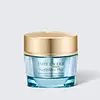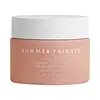What's inside
What's inside
 Key Ingredients
Key Ingredients

 Benefits
Benefits

 Concerns
Concerns

 Ingredients Side-by-side
Ingredients Side-by-side

Water
Skin ConditioningDimethicone
EmollientGlycerin
HumectantPolysorbate 60
EmulsifyingButyrospermum Parkii Butter
Skin ConditioningHydrogenated Polydecene
EmollientPropanediol
SolventSqualane
EmollientSorbitan Stearate
EmulsifyingCetyl Palmitate
EmollientTridecyl Stearate
EmollientLaminaria Saccharina Extract
Skin ProtectingLaminaria Ochroleuca Extract
Skin ConditioningGentiana Lutea Root Extract
Skin ConditioningHydrolyzed Rice Bran Extract
Skin ConditioningCitrus Reticulata Peel Extract
Skin ConditioningPsidium Guajava Fruit Extract
AstringentHydrolyzed Rice Extract
Skin ConditioningCitrus Limon Fruit Extract
MaskingFumaria Officinalis Flower/Leaf/Stem Extract
Skin ConditioningTriticum Vulgare Germ Extract
Skin ConditioningHordeum Vulgare Extract
EmollientPolygonum Cuspidatum Root Extract
AntioxidantThermus Thermophillus Ferment
Skin ConditioningCoffea Arabica Seed Extract
MaskingVitis Vinifera Seed Extract
AntimicrobialSaccharomyces Lysate Extract
HumectantLimonium Vulgare Flower/Leaf/Stem Extract
Skin ConditioningEthylbisiminomethylguaiacol Manganese Chloride
AntioxidantPalmitoyl Hydroxypropyltrimonium Amylopectin/Glycerin Crosspolymer
Skin ConditioningArtemia Extract
Skin ConditioningCholesterol
EmollientAlgae Extract
EmollientLinoleic Acid
CleansingDimethiconol
EmollientIsohexadecane
EmollientSodium Hyaluronate
HumectantLecithin
EmollientTridecyl Trimellitate
EmollientLauryl Alcohol
EmollientGlycyrrhetinic Acid
Skin ConditioningTrehalose
HumectantSucrose
HumectantErgothioneine
AntioxidantAcrylates/C10-30 Alkyl Acrylate Crosspolymer
Emulsion StabilisingDipentaerythrityl Hexacaprylate/Hexacaprate
EmulsifyingAcetyl Glucosamine
Skin ConditioningEthylhexylglycerin
Skin ConditioningButylene Glycol
HumectantGlyceryl Stearate
EmollientBehenyl Alcohol
EmollientCaffeine
Skin ConditioningPalmitic Acid
EmollientSodium PCA
HumectantStearic Acid
CleansingUrea
BufferingCaprylic/Capric Triglyceride
MaskingAcrylamide/Sodium Acryloyldimethyltaurate Copolymer
Emulsion StabilisingTocopheryl Acetate
AntioxidantTetrahexyldecyl Ascorbate
AntioxidantCetyl Alcohol
EmollientMyristyl Alcohol
EmollientPolyquaternium-51
Skin ConditioningCitric Acid
BufferingSodium Hydroxide
BufferingPolysorbate 80
EmulsifyingSodium Benzoate
MaskingFumaric Acid
BufferingCyclodextrin
AbsorbentParfum
MaskingDisodium EDTA
BHT
AntioxidantPhenoxyethanol
PreservativeChlorphenesin
AntimicrobialLinalool
PerfumingButylphenyl Methylpropional
PerfumingHydroxyisohexyl 3-Cyclohexene Carboxaldehyde
MaskingBenzyl Salicylate
PerfumingCI 42090
Cosmetic ColorantCI 19140
Cosmetic ColorantWater, Dimethicone, Glycerin, Polysorbate 60, Butyrospermum Parkii Butter, Hydrogenated Polydecene, Propanediol, Squalane, Sorbitan Stearate, Cetyl Palmitate, Tridecyl Stearate, Laminaria Saccharina Extract, Laminaria Ochroleuca Extract, Gentiana Lutea Root Extract, Hydrolyzed Rice Bran Extract, Citrus Reticulata Peel Extract, Psidium Guajava Fruit Extract, Hydrolyzed Rice Extract, Citrus Limon Fruit Extract, Fumaria Officinalis Flower/Leaf/Stem Extract, Triticum Vulgare Germ Extract, Hordeum Vulgare Extract, Polygonum Cuspidatum Root Extract, Thermus Thermophillus Ferment, Coffea Arabica Seed Extract, Vitis Vinifera Seed Extract, Saccharomyces Lysate Extract, Limonium Vulgare Flower/Leaf/Stem Extract, Ethylbisiminomethylguaiacol Manganese Chloride, Palmitoyl Hydroxypropyltrimonium Amylopectin/Glycerin Crosspolymer, Artemia Extract, Cholesterol, Algae Extract, Linoleic Acid, Dimethiconol, Isohexadecane, Sodium Hyaluronate, Lecithin, Tridecyl Trimellitate, Lauryl Alcohol, Glycyrrhetinic Acid, Trehalose, Sucrose, Ergothioneine, Acrylates/C10-30 Alkyl Acrylate Crosspolymer, Dipentaerythrityl Hexacaprylate/Hexacaprate, Acetyl Glucosamine, Ethylhexylglycerin, Butylene Glycol, Glyceryl Stearate, Behenyl Alcohol, Caffeine, Palmitic Acid, Sodium PCA, Stearic Acid, Urea, Caprylic/Capric Triglyceride, Acrylamide/Sodium Acryloyldimethyltaurate Copolymer, Tocopheryl Acetate, Tetrahexyldecyl Ascorbate, Cetyl Alcohol, Myristyl Alcohol, Polyquaternium-51, Citric Acid, Sodium Hydroxide, Polysorbate 80, Sodium Benzoate, Fumaric Acid, Cyclodextrin, Parfum, Disodium EDTA, BHT, Phenoxyethanol, Chlorphenesin, Linalool, Butylphenyl Methylpropional, Hydroxyisohexyl 3-Cyclohexene Carboxaldehyde, Benzyl Salicylate, CI 42090, CI 19140
Water
Skin ConditioningPropanediol
SolventDicaprylyl Carbonate
EmollientGlycerin
HumectantPentylene Glycol
Skin ConditioningSodium Hyaluronate
HumectantHydrolyzed Sodium Hyaluronate
Skin ConditioningGlycine
BufferingSerine
MaskingGlutamic Acid
HumectantAspartic Acid
MaskingLeucine
Skin ConditioningAlanine
MaskingLysine
Skin ConditioningArginine
MaskingTyrosine
MaskingPhenylalanine
MaskingProline
Skin ConditioningThreonine
Valine
MaskingIsoleucine
Skin ConditioningHistidine
HumectantAscorbic Acid
AntioxidantSaccharide Isomerate
HumectantHaematococcus Pluvialis Extract
AntioxidantCeramide NP
Skin ConditioningTocopheryl Acetate
AntioxidantTocopherol
AntioxidantHexapeptide-11
Skin ConditioningPalmitoyl Tripeptide-1
Skin ConditioningAnanas Sativus Fruit Extract
Skin ConditioningSaccharomyces/Magnesium Ferment
Saccharomyces/Copper Ferment
Skin ConditioningSaccharomyces/Silicon Ferment
Skin ConditioningButylene Glycol
HumectantGlyceryl Acrylate/Acrylic Acid Copolymer
HumectantGlyceryl Caprylate
EmollientSucrose Stearate
EmollientLecithin
EmollientPolyglyceryl-10 Laurate
Skin ConditioningXanthan Gum
EmulsifyingCetearyl Olivate
Sorbitan Olivate
EmulsifyingSodium Citrate
BufferingCarbomer
Emulsion StabilisingCitric Acid
BufferingCetearyl Alcohol
EmollientSodium Hydroxide
BufferingLactobacillus Ferment
Skin ConditioningLeuconostoc/Radish Root Ferment Filtrate
AntimicrobialHydroxyacetophenone
AntioxidantCI 77491
Cosmetic ColorantWater, Propanediol, Dicaprylyl Carbonate, Glycerin, Pentylene Glycol, Sodium Hyaluronate, Hydrolyzed Sodium Hyaluronate, Glycine, Serine, Glutamic Acid, Aspartic Acid, Leucine, Alanine, Lysine, Arginine, Tyrosine, Phenylalanine, Proline, Threonine, Valine, Isoleucine, Histidine, Ascorbic Acid, Saccharide Isomerate, Haematococcus Pluvialis Extract, Ceramide NP, Tocopheryl Acetate, Tocopherol, Hexapeptide-11, Palmitoyl Tripeptide-1, Ananas Sativus Fruit Extract, Saccharomyces/Magnesium Ferment, Saccharomyces/Copper Ferment, Saccharomyces/Silicon Ferment, Butylene Glycol, Glyceryl Acrylate/Acrylic Acid Copolymer, Glyceryl Caprylate, Sucrose Stearate, Lecithin, Polyglyceryl-10 Laurate, Xanthan Gum, Cetearyl Olivate, Sorbitan Olivate, Sodium Citrate, Carbomer, Citric Acid, Cetearyl Alcohol, Sodium Hydroxide, Lactobacillus Ferment, Leuconostoc/Radish Root Ferment Filtrate, Hydroxyacetophenone, CI 77491
 Reviews
Reviews

Ingredients Explained
These ingredients are found in both products.
Ingredients higher up in an ingredient list are typically present in a larger amount.
Butylene Glycol (or BG) is used within cosmetic products for a few different reasons:
Overall, Butylene Glycol is a safe and well-rounded ingredient that works well with other ingredients.
Though this ingredient works well with most skin types, some people with sensitive skin may experience a reaction such as allergic rashes, closed comedones, or itchiness.
Learn more about Butylene GlycolCitric Acid is an alpha hydroxy acid (AHA) naturally found in citrus fruits like oranges, lemons, and limes.
Like other AHAs, citric acid can exfoliate skin by breaking down the bonds that hold dead skin cells together. This helps reveal smoother and brighter skin underneath.
However, this exfoliating effect only happens at high concentrations (20%) which can be hard to find in cosmetic products.
Due to this, citric acid is usually included in small amounts as a pH adjuster. This helps keep products slightly more acidic and compatible with skin's natural pH.
In skincare formulas, citric acid can:
While it can provide some skin benefits, research shows lactic acid and glycolic acid are generally more effective and less irritating exfoliants.
Most citric acid used in skincare today is made by fermenting sugars (usually from molasses). This synthetic version is identical to the natural citrus form but easier to stabilize and use in formulations.
Read more about some other popular AHA's here:
Learn more about Citric AcidGlycerin is already naturally found in your skin. It helps moisturize and protect your skin.
A study from 2016 found glycerin to be more effective as a humectant than AHAs and hyaluronic acid.
As a humectant, it helps the skin stay hydrated by pulling moisture to your skin. The low molecular weight of glycerin allows it to pull moisture into the deeper layers of your skin.
Hydrated skin improves your skin barrier; Your skin barrier helps protect against irritants and bacteria.
Glycerin has also been found to have antimicrobial and antiviral properties. Due to these properties, glycerin is often used in wound and burn treatments.
In cosmetics, glycerin is usually derived from plants such as soybean or palm. However, it can also be sourced from animals, such as tallow or animal fat.
This ingredient is organic, colorless, odorless, and non-toxic.
Glycerin is the name for this ingredient in American English. British English uses Glycerol/Glycerine.
Learn more about GlycerinLecithin is a term for a group of substances found in the cell membranes of plants, animals, and humans. They are made up of mixture of phospholipids.
This ingredient has emollient and emulsifying properties.
As an emollient, lecithen helps soften the skin and creates a barrier to keep moisture in.
As an emulsifier, it also helps prevent water and oil ingredients from separating. Lecithin can also help ingredients be better absorbed by the skin.
This is because the phospholipids in lecithin produce liposomes. Liposomes help other ingredients get through the skin barrier.
Depending on the source of this ingredient, lecithin may not be fungal acne safe. This is because some sources of lecithin come from soybean oil, which may feed the malassezia yeast that feeds fungal acne.
We recommend reaching out to the brand you are purchasing from to inquire about the source of their lecithin.
Some other names for this ingredient include soy lecithin and deoiled soy lecithin.
Learn more about LecithinPropanediol is an all-star ingredient. It softens, hydrates, and smooths the skin.
It’s often used to:
Propanediol is not likely to cause sensitivity and considered safe to use. It is derived from corn or petroleum with a clear color and no scent.
Learn more about PropanediolSodium Hyaluronate is hyaluronic acid's salt form. It is commonly derived from the sodium salt of hyaluronic acid.
Like hyaluronic acid, it is great at holding water and acts as a humectant. This makes it a great skin hydrating ingredient.
Sodium Hyaluronate is naturally occurring in our bodies and is mostly found in eye fluid and joints.
These are some other common types of Hyaluronic Acid:
Learn more about Sodium HyaluronateSodium Hydroxide is also known as lye or caustic soda. It is used to adjust the pH of products; many ingredients require a specific pH to be effective.
In small amounts, sodium hydroxide is considered safe to use. However, large amounts may cause chemical burns due to its high alkaline.
Your skin has a natural pH and acid mantle. This acid mantle helps prevent harmful bacteria from breaking through. The acid mantle also helps keep your skin hydrated.
"Alkaline" refers to a high pH level. A low pH level would be considered acidic.
Learn more about Sodium HydroxideTocopheryl Acetate is AKA Vitamin E. It is an antioxidant and protects your skin from free radicals. Free radicals damage the skin by breaking down collagen.
One study found using Tocopheryl Acetate with Vitamin C decreased the number of sunburned cells.
Tocopheryl Acetate is commonly found in both skincare and dietary supplements.
Learn more about Tocopheryl AcetateWater. It's the most common cosmetic ingredient of all. You'll usually see it at the top of ingredient lists, meaning that it makes up the largest part of the product.
So why is it so popular? Water most often acts as a solvent - this means that it helps dissolve other ingredients into the formulation.
You'll also recognize water as that liquid we all need to stay alive. If you see this, drink a glass of water. Stay hydrated!
Learn more about Water